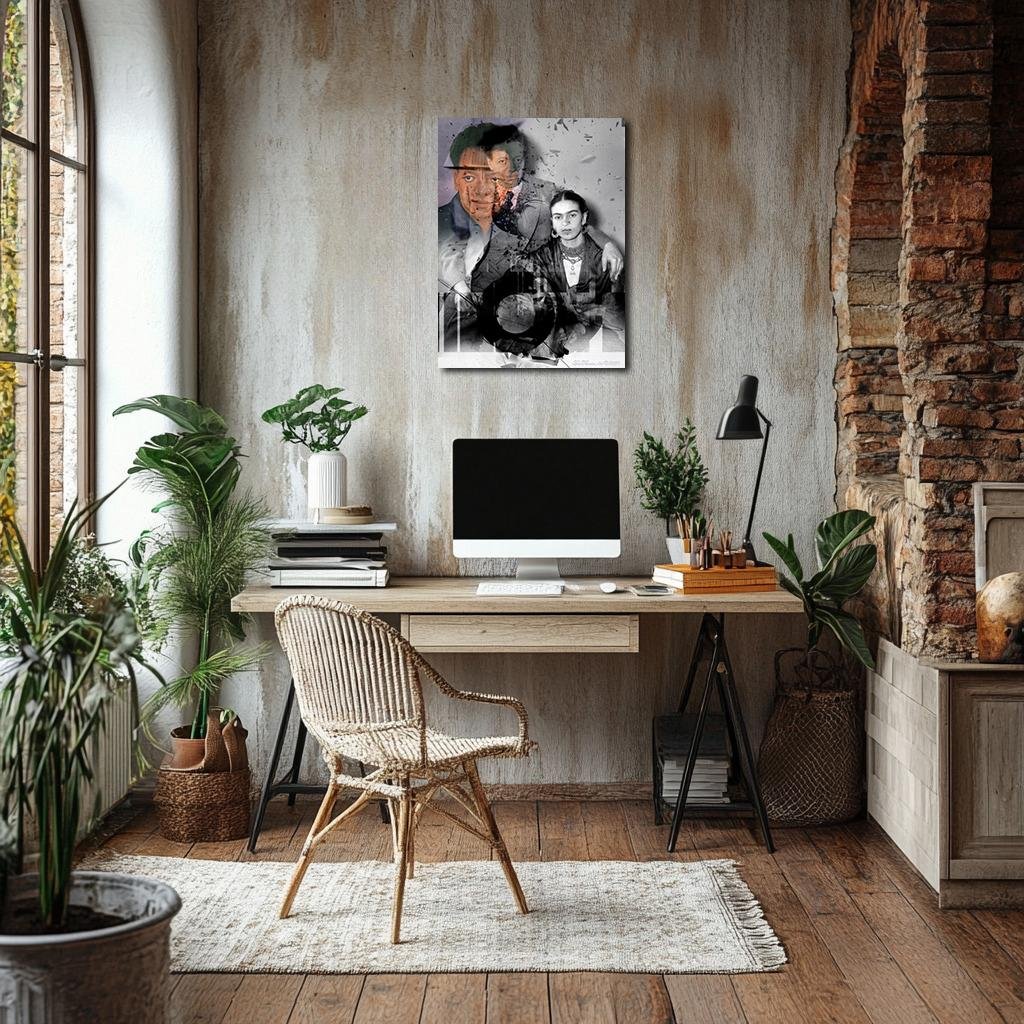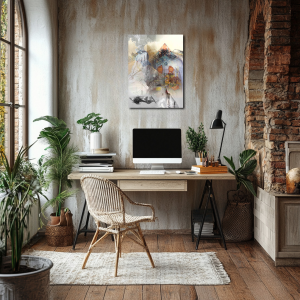Weight of His Shadow: Frida’s Portrait Within the Frame
Weight of His Shadow reimagines Frida Kahlo’s Portrait of Diego Rivera as a fractured meditation on love, legacy, and artistic gravity. Saturated with Rivera’s warm siennas and Kahlo’s grayscale stillness, the piece unfolds as a broken mirror—where glass shards, faded sketches, and angular ruptures reflect a relationship built on reverence and strain. Through its layered contrast of color, form, and silence, the work honors Frida’s portrait not as flattery, but as a confession of what it meant to carry him within her mind, even as she vanished from her own frame.
Please see Below for Details…
Hotline Order:
Mon - Fri: 07AM - 06PM
404-872-4663
This conceptual reimagining of Frida Kahlo’s Portrait of Diego Rivera ruptures the notion of a simple homage and reconstructs it as a shattered meditation on intimacy, identity, and artistic imbalance. Titled Weight of His Shadow , the piece revisits Kahlo’s attempt to paint Diego not as he was seen by the world, but as he existed within her—the looming, fractured presence that shaped her love, her pain, and her ever-strained sense of self. This is not merely a portrait of Rivera, but a mirror caught mid-crack, reflecting two entangled lives unraveling beneath the surface of devotion.
At the core of the composition, Rivera’s image multiplies and warps—a collage of overlaid faces, blurred contours, and distorted expressions. His larger-than-life visage consumes the upper canvas, bearing down on Frida’s smaller, seated form, who appears in grayscale as if preserved in mourning. Her expression is solemn but composed, her jewelry as precise and deliberate as her famously unflinching gaze. The hand of Rivera, once gently protective, now appears disembodied—resting on her shoulder with a ghostlike grip that suggests both possession and absence.
Frida’s own portrait dissolves into sharp, angular shards of graphite architecture—symbols of both construction and collapse. Her seated figure begins to fragment into broken glass and sketchlike blueprints, evoking the emotional wreckage and structural instability that defined her relationship with Diego. These fragments spread like a virus through the lower half of the work, implying that her presence, though central, is constantly contorted by the gravitational pull of his myth.
The color treatment in Weight of His Shadow follows a deliberate descent from warmth into rupture. Rivera’s face, saturated in burnt siennas, ochres, and coral undertones, seems to hover outside of realism—more icon than man. These earth-rich tones reference the monumental murals he painted, evoking the soil and sweat of the people he revered. But here, that same palette becomes almost suffocating—heavy, overpowering, unyielding in its dominance.
In stark contrast, Frida’s figure is drained of color. Rendered in grayscale with faint sepia washes, her skin and garments appear as though faded by grief or memory. The absence of hue does not diminish her presence—it magnifies it. Her stillness becomes sharper, more statuesque, framed by the chaos around her. It’s not just that color was taken from her, but that it was never fully hers within the landscape dominated by Rivera’s legend.
Across the upper background, a quiet storm of broken glass rains down in sharp, almost invisible streaks of black and transparent gray. These fragments refract glimpses of other faces, other forms—perhaps memories, perhaps shattered illusions. They shimmer briefly, then disappear, a haunting metaphor for the many selves Frida had to fracture in order to sustain the myth of their unity.
Around the borders of the composition, the color bleeds into industrial charcoal, graphite smudges, and cold titanium whites. These colors are architectural and calculated, suggesting the scaffolding of public image and artistic legacy. Yet their clinical tone contrasts painfully with the raw, human center of the piece: two artists, unequally framed, unequally remembered.
When I created Weight of His Shadow , I wanted to challenge the notion of portraiture as praise. Frida’s original Portrait of Diego Rivera was already a subversion—she painted him on her own forehead, a radical act of surrender and declaration. But I wanted to ask: what does it cost to carry someone else so completely inside your mind? In this reinterpretation, Diego is not only in her thoughts—he becomes her gravity, her architect, her erasure, and her muse. She is seated, still, but beneath the stillness is fragmentation, pressure, a quiet scream muted by reverence.
The compositional structure divides the image diagonally—Rivera ascending, luminous in warm color, while Frida descends, fading into shadow. Between them lies the fault line of their relationship, a fracture of broken glass and dreams. This imbalance does not suggest blame, but tension: the impossible task of loving a giant without disappearing beneath his feet.
Add your review
Your email address will not be published. Required fields are marked *
Please login to write review!
Looks like there are no reviews yet.








